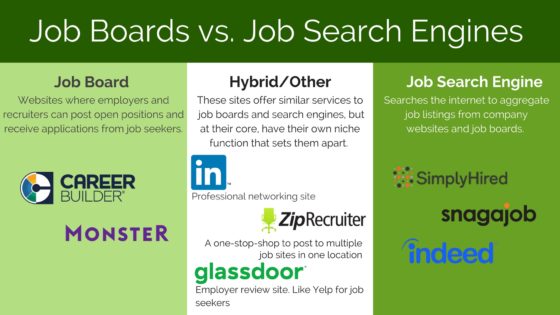Job Boards vs. Job Search Engines: What You Don’t Know May Cost You (Infographic)
Undoubtedly, job boards and job search engines are invaluable tools for recruiters and hiring managers. HR software company Silkroad reported that job boards and job search engines were the second most common source of hire in 2016. While the use of these types of websites is not likely to decline in the coming years, it is definitely projected to change with the evolution of artificial intelligence. Online statistics and analytics company Statistic Brain reported that the average cost for posting a job online for 30 days in 2017 is $268.25. Larger organizations will need to fill multiple jobs at a given time. These costs can add up quickly, and the results of these postings can vary quite a bit from source to source. When we talk about websites that are dedicated to employment and careers, we tend to group them all together under one heading. In reality, they each function differently, and provide some unique services. It is important for employers and recruiters to understand how each of these job sites functions in order to maximize the results, and minimize spending. According to the International Association of Employment Web Sites (IAEWS), there are at least 60,000 sites worldwide dedicated to employment. Below are a quick explanation, and an overview of some of the most recognizable sites to help you make an educated decision about where to put your money and resources.
Job Board
A job board is a website where companies can post their open jobs, and often receive direct applications from jobseekers. Some of the most well-known and widely used job boards are Monster and CareerBuilder. Job seekers can post resumes to both of these sites free of charge. Employers can post jobs on both of these for a fee. In addition to CareerBuilder and Monster, there are also quite a few niche job boards that are geared toward specific industries or levels of seniority. Dice.com is dedicated to jobs in the tech industry. Culintro.com is geared toward those pursuing jobs in the food and beverage industry. Whatever your company’s specialty, there is likely to be a job board that is specifically targeted to candidates in your industry, if you choose to pursue that option. If your organization is hiring for a very specific position requiring certain unique skills, this could be a good option for you.
Job Search Engine
Job search engines will literally search the internet and aggregate job listings from various job boards and company websites. Some of the most popular job search engines are SimplyHired, Snagajob and Indeed. Most of these do charge employers to post available jobs. Indeed does allow employers to post jobs for free, as long as they do not post that same open position anywhere else online, including their own company website. Like job boards, most job search engines allow candidates to create profiles and upload resumes for free.
LinkedIn and Other Major Job Sites
Among the many employment websites, there are some that do not necessarily fit into either of the Job Board or Job Search Engine category. They are hybrids of both, or they offer some other specific function that sets them apart. LinkedIn, for example, is neither a job board, nor a job search engine, Contrary to how it is often used now, it is really meant to be a professional networking site; a place where people can engage and exchange ideas with others in their industry. LinkedIn does offer employers and recruiters the opportunity to post jobs for a fee. It is common practice for employers and recruiters to post a link to their LinkedIn company page with a link to view an open job in order to avoid a job posting fee. While you may garner some results this way, depending on how many connections your company has, the reach will not be as great as for a paid posting. Arguably, not everyone is on LinkedIn to find a job, and you can run the risk of alienating valuable connections if you’re constantly filling up your feed with job links. Glassdoor initially launched as an employer review site. Often referred to as Yelp for job seekers, it allows employees to review employers based on things like salary, benefits, and effectiveness of management. While the review factor is probably its best asset and claim to fame, Glassdoor also offers employers the opportunity to post jobs for a fee. If you are an employer who has received positive reviews on Glassdoor, a job posting here might be beneficial for you. Zip Recruiter is basically a job board, but it allows you to post your job on 100+ job boards with just one submission. Unfortunately, Zip Recruiter does not partner with Indeed, and additional fees are charged to have your jobs posted to Monster and LinkedIn.
Some Variables to Consider
Cost
Cost is probably the most important driver for employers who are taking their job searches online, and it varies greatly from each source. A 2014 article by Glassdoor provides a fairly comprehensive look at the major job sites and their approximate fees. One thing to be aware of when choosing any paid job site posting is the length of the contract. They can be 30 days, 60 days, or even auto-renew and charge your credit card each month. Some sites charge a flat fee for a posting which will remain active for a certain timeframe, while others like Indeed, have a “pay per click” model. Your cost per click can range from anywhere from $0.10 to over $5 per click, and you’re paying for each job seeker that clicks on your post, even if they do not submit an application. You will need to be cautious about choosing, and vigilant in maintaining your paid posting to make sure you are getting the most out of it.
Go Where the Candidates Are
Another major qualifier when choosing which job sites to monetize is the quality of candidate experience offered by those sites. Glassdoor reports that 90% of job seekers are using their mobile device to search for jobs, and another 44% of those candidates applying directly from a mobile device. You’ll want to choose those that are the most mobile-friendly, since that is where the most candidates are likely to be. The option to apply directly from a mobile device is also becoming increasingly important. A survey by Business World Daily revealed that nearly one-third (30 percent) of all candidates won’t spend more than 15 minutes filling out an online application. Any job search site that also has an app option is integral in saving candidates valuable time. Apps also help job seekers keep their resume, cover letter, and listings handy at all times, making it easier for them to apply on-the-go. Some apps also offer job seekers the option to hear about open positions through push notifications to their mobile phone. This is like a text message that alerts the candidate that a positon fitting their skills and background is available. The good news is that all of the above referenced companies now have mobile apps. The functionality varies, but the technology is improving all the time in an effort to surpass the competition.
Traffic
The amount of traffic to these sites is also something to consider. You can investigate the amount of traffic a job site experiences using SimilarWeb, or comparable digital market intelligence platform. For example, SimilarWeb indicates that Indeed.com is ranked #1 in the category of Jobs and Employment websites, with 263.9 million visits in April of 2017. While the number of candidates that see your job post is important, the caliber of candidates is what you’re really interested in. Consider the demographics of the audience on a site to place your job in the best location. Quantcast is a fabulous free resource for exploring the demographics of websites and apps.
The Quality/Quantity Question
Once you’ve narrowed your choices, you may wish to visit each site you’re considering and do a search for the most common positions your organization sources. If you get a large number of results, you are probably in the right place. You could argue that you might be more likely to stand out if your position is not immersed in a sea of other similar positions. But remember, you want to be where the candidates are. If a job site rarely has available HR positions, candidates who are seeking jobs in HR will most likely migrate to other sites where they have more options. If you’re concerned about your job post standing out from the rest, one way you can achieve this is by using an extended title. For example, instead of just “HR Specialist”, you could say “HR Specialist – Global Pharmaceutical Organization.” We will discuss this technique more in a future post.
The Numbers Don’t Lie
No matter what job site you choose for your paid job posting, you should track your results in order to justify the expense. You can do this using something as simple as an Excel spreadsheet, or your own Applicant Tracking System (ATS) if you have one. You may find that different job sites yield different results for your organization. A posting on one site may result in more interviews, while another results in more hires. You may find that despite a paid posting, you end up having more hires that come from their own internal database. If you don’t track the outcomes, you’ll never know where best to allocate your expense.
Diversify Your Recruiting Strategies for Success
Arguably, many employers and hiring managers would have a very difficult time sourcing today without the help of job sites to reach qualified candidates. In an article by the Society for Human Resource Management (SHRM), HR Industry thought leader John Sullivan declared 2017 “the year of the algorithm.” Data-driven results, delivered through smart search technology by companies like Google, will continue to be vital to employers and HR departments. However, it will be necessary to diversify your recruiting efforts to truly maximize your talent pipeline, and attract the best candidates to your organization. Technology, combined with employee referrals, a focus on employer branding, a solid onboarding process, a strong mobile presence, and a return to true headhunting will all be necessary to find and attract the best candidates to your organization. The best recruiting is done using a mixture of all of these sources.
Bradley Staffing Group is a full-service staffing firm based in Wayne, PA. We are committed to matching A-level talent with best-in-class businesses. Our knowledgeable and well-trained staff brings a combined 70+ years of staffing experience to our clients and candidates alike. http://useful-sock.flywheelsites.com/employers/











Leave a Reply